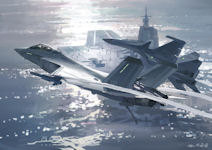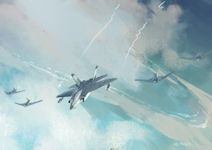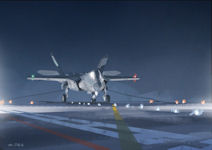J-35 Carrier-Based Stealth Fighter
 Unofficial sources claim the PLA Navy has named their new generation carrier based stealth fighter the J-35, as the "J-31" was never recognized by the PLA. People's Daily reported 30 June 2020 that China's new-generation fighterjet is scheduled to make its maiden flight in 2021, an aviation industry report revealed. Analysts speculate it will be China's new aircraft carrier-based fighter jet.
Unofficial sources claim the PLA Navy has named their new generation carrier based stealth fighter the J-35, as the "J-31" was never recognized by the PLA. People's Daily reported 30 June 2020 that China's new-generation fighterjet is scheduled to make its maiden flight in 2021, an aviation industry report revealed. Analysts speculate it will be China's new aircraft carrier-based fighter jet.
New photos of a prototype FC-31, China's second type of stealth fighter jet, have been appearing frequently on Chinese social media since May 2020, years after disappearing from the public eye. Now painted in a silver gray coating, its development is making smooth progress. A new set of photos of what seems to be an FC-31 fighter jet on a test flight was posted on Sina Weibo on 25 May 2020. This was not the first time the aircraft has made an appearance recently, as some photos were also posted by another Sina Weibo user on May 18.
Unlike photos taken in previous years, the FC-31 prototype in the new photos is painted with silver gray coating, eastday.com said. It seems to be an upgraded version with modifications made to its aerodynamic design just like the prototype that made its maiden flight in 2016, instead of the original version that made its public debut at Airshow China in 2014.
According to a statement released by the Shenyang institute in December 2019, it has started developing a new type of fighter jet jointly with AVIC Manufacturing Technology Institute since 2018. This older report did not elaborate on the specifics of the new aircraft. The Shenyang institute is known for the development of the J-15, China's first type of aircraft carrier-based fighter jet, and the FC-31, China's second type of stealth aircraft rumored to be under deep modification to become a new aircraft carrier-based fighter jet.
The cost of the aircraft carrier hull is equivalent to the cost of the carrier-based aircraft, and the stealth fighter is the most expensive of the carrier-based aircraft. The entry into service of the new stealth carrier-based aircraft will not eliminate the third-generation carrier-based aircraft. On the contrary, they will be used in conjunction and complement each other. In air combat, stealth aircraft should try to avoid close-range combat, because it will lose the most important advantage of radar stealth, and the subsonic mobility is not higher than that of the third-generation aircraft. Therefore, once the beyond-horizon air-to-air missile has been launched, it should be withdrawn from the battlefield by means of supersonic cruise, and the rest will be handled by the third-generation aircraft. Therefore, the new stealth carrier-based aircraft does not need to mount close-range rounds and install cannons.
Without a cannon, there is no need to carry shells, and it can save nearly a hundred kilograms of ammunition weight. The payload (including the pilot) of the new stealth carrier aircraft under air combat is about 1 ton. The total weight of dry weight, internal oil and load is about 24 tons, which is between F-35A and F-35C, and the fuel coefficient is 0.38. Because the fuel consumption rate of the double mid-engine is slightly higher than that of the single big-engine, both of them add 9 tons of fuel, and the range is slightly lower than that of the F-35C, but it also reaches 2,000 kilometers. At the same time, it can also bring two auxiliary fuel tanks thrown together with the pylon. Three tons of external fuel can make the range of 3,000 kilometers without air refueling. The modified auxiliary fuel tank designed for F-35A, which contains less oil than the ordinary cylindrical main auxiliary fuel tank, but has optimized aerodynamics. The auxiliary fuel tank of the new stealth carrier aircraft can also be repaired according to the situation. Although the fuel capacity is reduced, the resistance is also reduced, and the range may rise instead of reducing. Of course, the cost of the auxiliary fuel tank will increase, but unless it is fighting, the auxiliary fuel tank can be used repeatedly.
The most important thing is the early warning aircraft. Even with a fixed-wing early warning aircraft, due to safety considerations, the early warning aircraft must not go forward indefinitely, but must hide inside the air defense circle to avoid being "decapitated" by the enemy. The forward distance of the early warning aircraft and the limit of the radar line of sight are almost within 1 thousand kilometers, so the combat radius of the new stealth carrier-based aircraft is enough to have a thousand kilometers. When performing air alert missions, several stealth aircraft can be refueled in the air for a long time in the area close to the aircraft carrier. Once the early warning aircraft finds the situation, they can go quickly.
Comparing F-35A and F-35C, the external capacity of the new stealth carrier aircraft can reach about 6 tons. In this way, the maximum take-off weight can reach 30 tons. The same is the 30-ton level. Due to the difference in wing area, the maximum wing load of the F-35 series is very different, from 700 kg per square meter for F-35A to a little more than 500 for F-35C. The wing load of the new stealth carrier aircraft is about 500 kg per square meter, which is between F-22 and F-35C. Wing loading is related to maneuverability: The large wing loading of F-35A makes it less bumpy during low-altitude penetration, but the circling radius is too large during air combat, making it more like a fighter-bomber like the Flying Leopard. The new stealth carrier-based aircraft has a wing load similar to that of the F-22, making it easier to take advantage of the battle position when turning quickly.
Fighter performance and thrust-to-weight ratio are highly correlated. To ensure sufficient air combat maneuverability, the thrust-to-weight ratio of the fighter aircraft in the afterburner state should be higher than 1, so that it can quickly climb vertically. In order to achieve supersonic cruise, the thrust-to-weight ratio of fighter jets in the state of military thrust without afterburner should not be less than 0.7. Upon reaching the combat airspace, the fighter’s internal fuel has consumed a half. At this time, both the thrust-to-weight ratio and the thrust-to-weight ratio of the new stealth carrier-based aircraft can meet the requirements. In this way, the afterburner speed can reach twice the speed of sound, and the maximum cruise can exceed the speed of sound.
The supersonic cruise capability is the unique advantage of the stealth machine. Although some third-generation aircraft can super-cruise without an afterburning (such as the single-engine Gripen E), the super-cruise has practical significance for stealth aircraft with built-in missiles. The super cruise capability of the new stealth carrier aircraft can make it fast in and out in air combat, and the missile can hit farther, just like a boxer with long arms and fast legs, standing in an invincible position on the battlefield. The duct in the F135 has too much resistance than the engine fan, making all models of the F-35 series unable to supercruise. Although the F-35C can fly faster than the speed of sound when the afterburner is turned on, it is generally specified that the maximum speed of 1.3 Mach cannot exceed 50 seconds (F-35B only has 40 seconds, and F-35A has no time limit), let alone super cruising at the speed of sound.
The Chinese People's Liberation Army (PLA) Navy stated on 22 September 2025 that China's first electromagnetic catapult-equipped aircraft carrier, the Fujian, had achieved a breakthrough by hosting the first catapult-assisted takeoff and arrested landing training for the J-15T heavy fighter jet, the J-35 stealth fighter jet, and the KJ-600 early warning aircraft. The radar cross section (RCS) of China's J-35 series fighter jet is smaller than a human palm, thanks to its special fuselage design and metamaterial technologies exclusive to China, official media revealed on 28 Septembe 2025. An expert said this indicates the J-35's world-class stealth capability, giving the Chinese warplane a significant advantage. The details on the J-35 series' stealth capability were provided in an in-depth report by China Central Television (CCTV) News on Sunday. Wang Ya'nan, chief editor of Beijing-based Aerospace Knowledge magazine, told the Global Times that an RCS the size of a human palm, or roughly that of a sparrow, should be considered very small for an aircraft. It means that the J-35's stealth capability is at a world-class level. Such a small RCS can enable the J-35 to remain undetected until it is very close to its target, giving it more advantages and opportunities in combating, Wang Ya'nan said. CCTV News also introduced another key performance parameter of the J-35. The report revealed that the maximum takeoff weight of the J-35 is close to 30 tons and is powered by two medium-thrust engines completely independently developed by China. Wang Ya'nan said that while the J-35 is a medium-sized fighter jet, a maximum takeoff weight of nearly 30 tons means that it is almost a heavy fighter jet. Thanks to the electromagnetic catapult technology, the J-35 can take off fully loaded with munitions and fuel, giving it a longer range and endurance and stronger fire power.
| Parameter | Value / Range | Notes / Variant |
|---|---|---|
| Role | Stealth multirole fighter | Carrier version & land-based version (J-35A) |
| First Flight | 29 October 2021 (naval) / 26 September 2023 (J-35A) | Based on FC-31 lineage |
| Role | Stealth multirole fighter (carrier-borne & land-based) | |
| Manufacturer | Shenyang Aircraft Corporation (AVIC), China | |
| Status | Introduced September 2025 (reported) | |
| First Flights | J-35 (naval): 29 Oct 2021 J-35A (land): 26 Sep 2023 |
|
| Status | In service (from 2025) | Introduced 3 September 2025 |
| National Origin / Manufacturer | China / Shenyang Aircraft Corporation (AVIC) | Developed from FC-31 design |
| Engines | WS-19 (planned production) / WS-21 / WS-13E (earlier) / RD-93 (prototype) | Transitional engine options during development |
| Maximum Speed | ~ Mach 2 (some claims) / ~ Mach 1.8 (other sources) | Conflicting reports. |
| Combat Radius / Range | ˜ 648 nmi (under “regular combat load”) | From FC-31 baseline numbers |
| Internal Payload (weapons bay) | 6 air-to-air missiles (PL-10, PL-15, PL-21) / precision bombs / small diameter bombs etc. | Also external hardpoints available |
| External Hardpoints | 6 wing hardpoints (approx.) | Mixed external loadouts possible |
| Radar Cross Section (RCS) | Reported ~0.01 m² (claimed) | Very speculative / promotional figure |
| Design Features | Stealth shaping, internal bay, edge alignment, serrated paneling, folded wings (naval), catapult launch bar, recovery tailhook | Variants differ (J-35 naval version vs J-35A land) |
| Length | ~17.3 m (56 ft 9 in) | |
| Wingspan | ~11.5 m (37 ft 9 in) unfolded; smaller folded (naval) | |
| Height | ~4.8 m (15 ft 9 in) | |
| Wing Area | ~40 m² (431 ft²) | |
| Engines | 2 × WS-19 (planned); earlier WS-13E / WS-21 / RD-93 (prototype) | |
| Thrust (with afterburner) | ~100–110 kN (22,000–24,700 lbf) each | |
| Maximum Speed | Mach 1.8 – Mach 2.0 (sources vary) | |
| Service Ceiling | ~15,000 m (49,000 ft) | |
| Combat Radius | ~1,200 km (648 nmi) | |
| Ferry Range | ~2,000 km+ with external tanks | |
| Rate of Climb | >250 m/s (estimated) | |
| Radar | AESA radar (type undisclosed) | |
| Other Sensors | EOTS-style IRST, optical tracking, data links, glass cockpit | |
| Internal Weapons Bay | Up to 6 × PL-10, PL-15, or PL-21 AAMs; precision-guided bombs | |
| External Hardpoints | 6+ (compromises stealth) | |
| Stealth Features | Edge-aligned shaping, serrated panels, RAM coatings, internal bays | |
| Claimed RCS | ~0.01 m² (likely optimistic) | |
| Carrier Features | Folding wings, catapult launch bar, strengthened landing gear, arrestor hook |
|
NEWSLETTER
|
| Join the GlobalSecurity.org mailing list |
|
|
|






